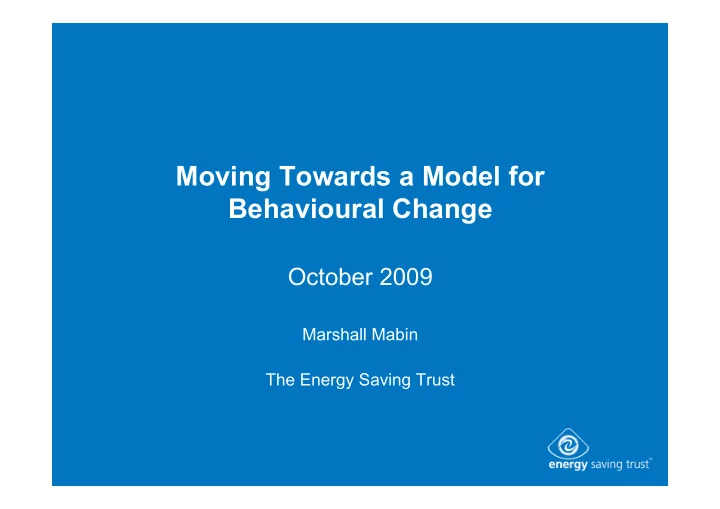

Moving Towards a Model for Behavioural Change October 2009 Marshall Mabin The Energy Saving Trust
Agenda • Introduction to Energy Saving Trust • Background and Objectives to Behavioral Research • Main Findings • Concluding remarks
Who are we? • Energy Saving Trust • One of the UK's leading organisations to address the damaging effects of climate change • Independent, not for profit organisation, set up in 1992 as a result of the Rio Summit • Aim to cut emissions of carbon dioxide (CO2) by promoting the sustainable and efficient use of energy in the domestic sector
What we do • Mission: To lead 60 million people to act on climate change, so an 80 per cent reduction in CO2 becomes a reality by 2050 • Develop and implement programmes to promote energy saving behaviour amongst consumers: – Energy efficiency installations (e.g Insulation) – Habitual changes (e.g. turning lights off in empty rooms) • EST undertakes programmes in a number of areas including consumer, local authorities, transport, renewables and supply chain. • For purposes of this study we will be focussing on the consumer programme which is delivered through three main channels: – Advice Centres – Web – Advertising and Promotion
Evaluation: Impact Assessment – Influenced CO2 Savings • Produce Annual and Lifetime CO2 Savings, based on standard CO2 saving assumptions • Quantitative surveys of a representative sample of customers • Survey 3-6 months after advice has been provided • Supported by in-depth qualitative interviews with survey respondents • One of the difficulties: Lack of data on low and no cost behavioural change – how long do habitual behavioural changes last for?
Research Objectives • How long do habitual behaviours last for? • Do habitual energy saving behaviours relapse over time? • Have people looked to undertake further changes overtime?
Customer Journey for Behavioural Change
Methodology • Longitudinal quantitative study with follow-on qualitative interviews conducted with individuals who had – Participated in main evaluation over past 3-4 years – Made a behavioural change and attributed change to EST advice • 564 quantitative telephone interviews with customers originally interviewed in consumer evaluations between 05/06 and 07/08. • 20 one-to-one in-depth qualitative interviews also conducted with customers who had taken part in the quantitative interview stage.
Research Considerations • EST customers only • NOT representative of different attitudinal groups e.g. More apathetic consumers. • Sample profile is typical of EST customer base • Longevity could only be assessed for four main behavioural measures: – Turning off lights; – Only wash full load; – Boiling only water needed; – Turning down thermostat by 1 degree;
Percentage of Sample Carrying out the Behavioural Measures
Length of Time Carrying out Behaviour Measure • Most/All practicing behaviours also predicted they would carry on indefinitely
Findings • For customers that we know followed our advice; the behaviours lasted for at least 3 years (based on 3 years of data we have ); • However; there was a drop off (or relapse) of about 4-15% of customers. • Furthermore; drop off varied on the type of measure % of Customers not doing anymore ‘Easier to maintain’ ‘More difficult to maintain’ • Turning off lights- 4% • Turning down thermostat- 15% • Washing on full load- 5% • Boiling only water needed- 11% • Therefore results indicate behaviors do stick, but some are more difficult to maintain than others
Findings cont… • Almost all customers who followed our advice were found to have undertaken significant further action since initial interaction with EST. • Customers also indicated a need for more in-depth advice
Conclusions • Certain behaviours more widely practiced than others; • Some behaviours are more ‘mature’ than others; • Once a behavioural change is made they are generally habit forming; however some measures are difficult to maintain than others. – Most customers are continuing to practice behaviours 3 years on – Drop off of between 4 and 15% across behaviours • Evidence suggests that different behaviours may warrant different approaches – E.g. Seasonal campaign for Thermostats – Legislation?
Conclusions cont… • Large proportion of customers who made a small behavioural change have since gone on to do more significant measures. • Suggests that behaviours may act as point of inception along a customer journey; • EST will do further work to build a model of behavioural changes based on drivers, barriers and persistence data; • Study to be published in December 09; • Persistence research will be repeated annually to build on three years of data.
Thank- You Any Questions?
Recommend
More recommend